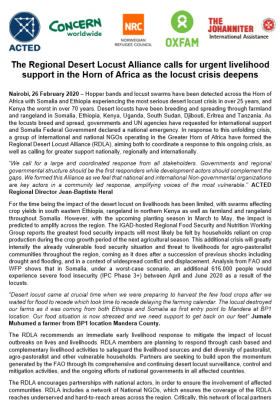
Nairobi, 26 February 2020 – Hopper bands and locust swarms have been detected across the Horn of Africa with Somalia and Ethiopia experiencing the most serious desert locust crisis in over 25 years, and Kenya the worst in over 70 years. Desert locusts have been breeding and spreading through farmland and rangeland in Somalia, Ethiopia, Kenya, Uganda, South Sudan, Djibouti, Eritrea and Tanzania. As the locusts breed and spread, governments and UN agencies have requested for international support and Somalia Federal Government declared a national emergency. In response to this unfolding crisis, a group of international and national NGOs operating in the Greater Horn of Africa have formed the Regional Desert Locust Alliance (RDLA), aiming both to coordinate a response to this ongoing crisis, as well as calling for greater support nationally, regionally and internationally.
We call for a large and coordinated response from all stakeholders. Governments and regional governmental structure should be the first responders while development actors should complement the gaps. We formed this Alliance as we feel that national and international Non-governmental organizations are key actors in a community led response, amplifying voices of the most vulnerable.
For the time being the impact of the desert locust on livelihoods has been limited, with swarms affecting crop yields in south eastern Ethiopia, rangeland in northern Kenya as well as farmland and rangeland throughout Somalia. However, with the upcoming planting season in March to May, the impact is predicted to amplify across the region. The IGAD-hosted Regional Food Security and Nutrition Working Group reports the greatest food security impacts will most likely be felt by households reliant on crop production during the crop growth period of the next agricultural season. This additional crisis will greatly intensify the already vulnerable food security situation and threat to livelihoods for agro-pastoralist communities throughout the region, coming as it does after a succession of previous shocks including drought and flooding, and in a context of widespread conflict and displacement. Analysis from FAO and WFP shows that in Somalia, under a worst-case scenario, an additional 616,000 people would experience severe food insecurity (IPC Phase 3+) between April and June 2020 as a result of the locusts.
Desert locust came at crucial time when we were preparing to harvest the few food crops after we waited for flood to recede which took time to recede delaying the farming calendar. The locust destroyed our farms as it was coming from both Ethiopia and Somalia as first entry point to Mandera at BP1 location. Our food situation is now stressed and we need support to get back on our feet.
The RDLA recommends an immediate early livelihood response to mitigate the impact of locust outbreaks on lives and livelihoods. RDLA members are planning to respond through cash based and complementary livelihood activities to safeguard the livelihood sources and diet diversity of pastoralist, agro-pastoralist and other vulnerable households. Partners are seeking to build upon the momentum generated by the FAO through its comprehensive and continuing desert locust surveillance, control and mitigation activities, and the ongoing efforts of national governments in all affected countries.
The RDLA encourages partnerships with national actors, in order to ensure the involvement of affected communities. RDLA includes a network of National NGOs, which ensures the coverage of the RDLA reaches underserved and hard-to-reach areas across the region. Critically, this network of local partners provides a direct pathway to mobilize communities to understand, monitor and respond to the locust crisis.
RDLA partners call on donors to initiate timely funding for livelihood protection and early recovery activities now, rather than waiting and having to provide an expensive emergency response later in the year. Anticipatory funding will enable NGOs to position and respond rapidly as the impact of the desert locusts becomes clearer after the upcoming rainy season. The simultaneous implementation of control and livelihood activities is a critical lesson learnt from the response to the locust outbreak in the Sahel that should be replicated.
Vulnerable and displaced people across East Africa are just starting to recover from severe drought and flooding. With humanitarian funding levels are far below what is required to cope with the existing crises, the predicted loss of crops and livestock feed from the locust invasion will potentially exacerbate food insecurity and threaten the livelihoods of hundreds of thousands more people.
For further information and requests, please contact:
- Duncan Wall / ACTED Media and Campaigns Manager – Duncan.wall@acted.org
- Martin Mamsaka / OXFAM Regional Media and Communications Advisor- namasaka@oxfam.org
- Jeremy Taylor / NRC Regional Advocacy Advisor, taylor@nrc.no
The Regional Desert Locust Alliance calls for urgent livelihood support in the Greater Horn of Africa as the locust crisis deepens
Download